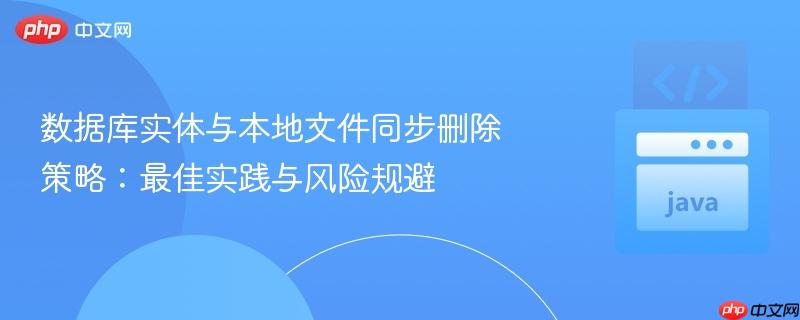
本文探讨了在数据库实体与本地文件存在关联时,如何确保两者同步删除的策略。主要介绍了两种方法:通过服务层事务性删除,强调原子性与即时一致性;以及通过定时任务进行异步清理,分析其优势与潜在的竞态条件风险,并提供相应的规避建议。
在现代应用开发中,将文件(如用户头像、图片等)存储在本地文件系统,而将文件路径存储在数据库中是一种常见模式。然而,当需要删除数据库中的实体时,如何确保其对应的本地文件也能被同步、安全地删除,成为了一个需要深思熟虑的问题。仅仅删除数据库记录,而不处理本地文件,将导致文件系统中的“孤儿文件”,浪费存储空间并可能造成数据不一致。本文将深入探讨两种主流的同步删除策略,并分析其优缺点及实现细节。
这种方法将数据库实体的删除操作与本地文件的删除操作封装在一个事务中,以确保原子性。这是处理此类问题最直接且推荐的方式,尤其适用于对数据一致性要求较高的场景。
将数据库操作和文件系统操作置于同一个事务边界内。这意味着如果任何一个操作失败(无论是数据库删除还是文件删除),整个事务都会回滚,从而保证数据库和文件系统始终保持同步状态。
import org.springframework.stereotype.Service;
import org.springframework.transaction.annotation.Transactional;
import java.io.IOException;
import java.nio.file.Files;
import java.nio.file.Path;
import java.nio.file.Paths;
import java.util.Optional;
@Service
public class ChannelService {
private final ChannelRepository channelRepository;
private final String uploadDir = "/path/to/your/avatar/storage/"; // 你的文件存储路径
public ChannelService(ChannelRepository channelRepository) {
this.channelRepository = channelRepository;
}
@Transactional
public void deleteChannelAndAvatar(Long channelId) {
Optional<Channel> channelOptional = channelRepository.findById(channelId);
if (channelOptional.isPresent()) {
Channel channel = channelOptional.get();
String avatarPath = channel.getAvatarPath(); // 假设Channel实体有getAvatarPath方法
// 1. 先删除数据库实体
channelRepository.delete(channel);
// 2. 后删除本地文件
if (avatarPath != null && !avatarPath.isEmpty()) {
try {
Path filePath = Paths.get(uploadDir, avatarPath);
if (Files.exists(filePath)) {
Files.delete(filePath);
System.out.println("Deleted local avatar file: " + filePath);
}
} catch (IOException e) {
// 文件删除失败,事务将回滚,数据库实体不会被删除
System.err.println("Failed to delete local avatar file: " + avatarPath + ", error: " + e.getMessage());
throw new RuntimeException("Failed to delete local avatar file", e);
}
}
} else {
throw new IllegalArgumentException("Channel with ID " + channelId + " not found.");
}
}
}除了即时删除,另一种辅助或独立的策略是使用定时任务(Scheduled Job)定期扫描文件系统,清理那些不再被数据库实体引用的“孤儿文件”。
解耦文件清理与主业务流程,通过周期性检查来发现并删除那些在文件系统中存在但数据库中已无对应记录的文件。这种方法可以作为策略一的补充,以处理因各种意外情况(如系统崩溃、手动误操作等)导致的遗留文件。
import org.springframework.scheduling.annotation.Scheduled;
import org.springframework.stereotype.Component;
import java.io.IOException;
import java.nio.file.Files;
import java.nio.file.Path;
import java.nio.file.Paths;
import java.util.Set;
import java.util.stream.Collectors;
import java.util.stream.Stream;
@Component
public class OrphanedFileCleanupScheduler {
private final ChannelRepository channelRepository;
private final String uploadDir = "/path/to/your/avatar/storage/"; // 你的文件存储路径
public OrphanedFileCleanupScheduler(ChannelRepository channelRepository) {
this.channelRepository = channelRepository;
}
// 每小时执行一次,清理孤儿文件
@Scheduled(fixedRate = 3600000) // 1 hour in milliseconds
public void cleanupOrphanedAvatars() {
System.out.println("Starting orphaned avatar cleanup job...");
try {
// 1. 获取数据库中所有被引用的头像路径
Set<String> referencedAvatarPaths = channelRepository.findAll()
.stream()
.map(Channel::getAvatarPath)
.filter(path -> path != null && !path.isEmpty())
.collect(Collectors.toSet());
// 2. 遍历本地文件系统中的头像文件
Path dirPath = Paths.get(uploadDir);
if (Files.exists(dirPath) && Files.isDirectory(dirPath)) {
try (Stream<Path> files = Files.list(dirPath)) {
files.forEach(filePath -> {
String fileName = filePath.getFileName().toString();
// 3. 比对并删除孤儿文件
if (!referencedAvatarPaths.contains(fileName)) {
try {
Files.delete(filePath);
System.out.println("Deleted orphaned avatar file: " + filePath);
} catch (IOException e) {
System.err.println("Failed to delete orphaned avatar file: " + filePath + ", error: " + e.getMessage());
}
}
});
}
}
} catch (IOException e) {
System.err.println("Error during orphaned avatar cleanup: " + e.getMessage());
}
System.out.println("Orphaned avatar cleanup job finished.");
}
}定时任务清理虽然灵活,但存在一个关键的竞态条件(Race Condition)风险:
在数据库实体与本地文件同步删除的问题上,服务层事务性删除是首选方案,它提供了即时的一致性和原子性保证,是确保核心业务数据完整性的基石。
异步定时任务清理则作为一种辅助或兜底机制,用于处理因各种意外情况导致的孤儿文件。但在实现时,必须高度警惕并有效规避竞态条件,特别是通过引入宽限期或临时目录等手段,以防止误删正在上传或即将被引用的文件。
综合来看,一个健壮的系统通常会结合这两种策略:使用事务性删除确保日常操作的即时一致性,并辅以精心设计的定时清理任务来处理潜在的残留问题,从而实现文件系统与数据库之间的高度同步和数据完整性。
以上就是数据库实体与本地文件同步删除策略:最佳实践与风险规避的详细内容,更多请关注php中文网其它相关文章!

每个人都需要一台速度更快、更稳定的 PC。随着时间的推移,垃圾文件、旧注册表数据和不必要的后台进程会占用资源并降低性能。幸运的是,许多工具可以让 Windows 保持平稳运行。

Copyright 2014-2025 https://www.php.cn/ All Rights Reserved | php.cn | 湘ICP备2023035733号